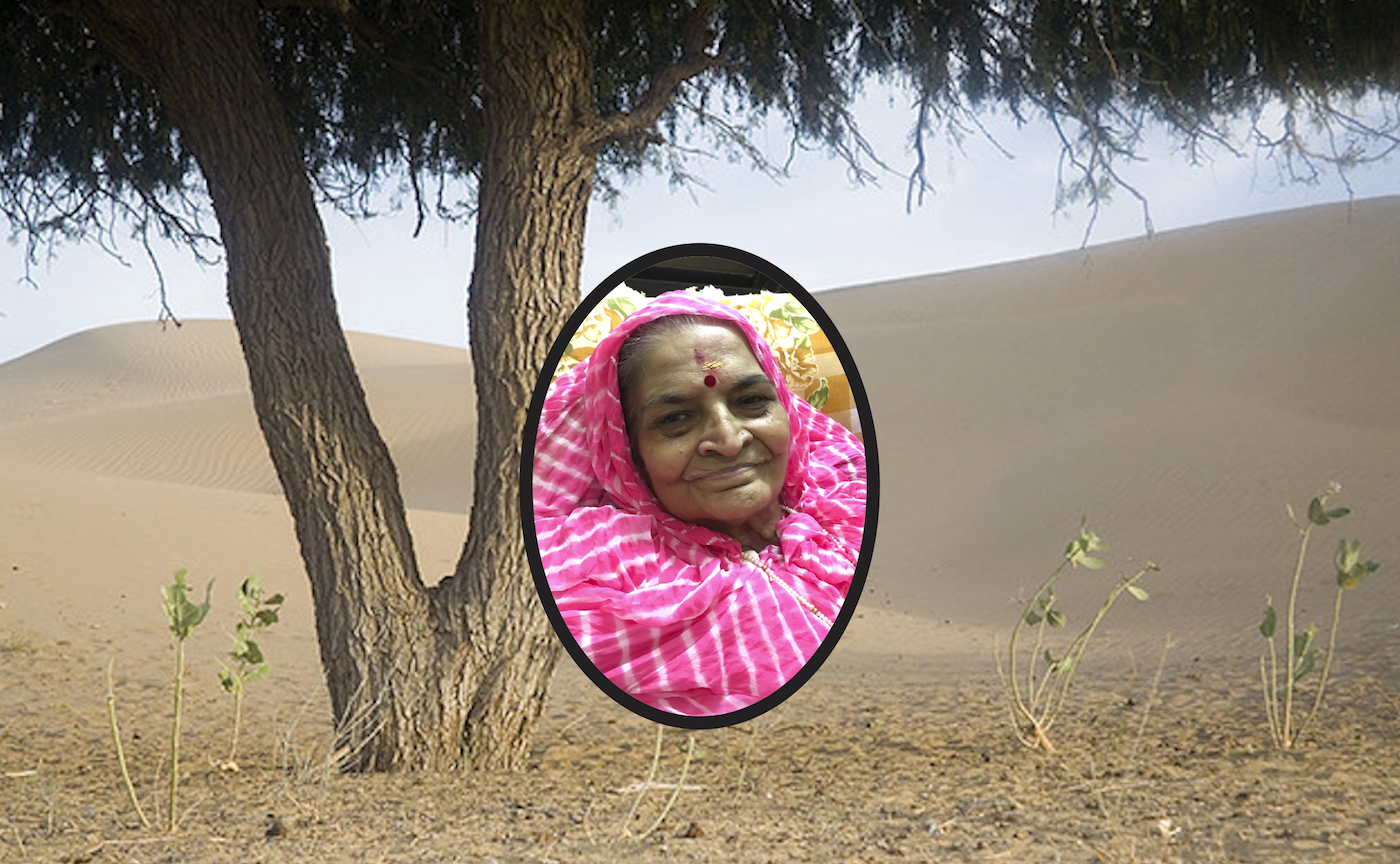Ode to Kaushalya, My Mother Who Like the Khejri Tree is a True Daughter of Rajasthan

As I sit in my library in these surreal lonely times of the pandemic. I find a scrap of paper tucked away in a book. It is an epistle addressed to me from my mother. The exquisite words inscribed on a piece of paper no larger than a Post-it note convey her love for me, and transport me to her homeland of magical sunsets and heart rending melodies, inspiring me to hum the quintessential song of the land:
Kesariya Balam Aavo Ni
Padharo Ni… Mhare Des…
(“My saffron-hued beloved, come!
Come home to my land”)
In my trance-like state I see a turbaned street singer with a handlebar mustache playing on his tanpura, his eyes closed, invoking the spirit of nature. In my mind’s eye, his patient camel sits beside him and his song mingles with the mating calls of peacocks. In another such visual, etched in my mind from my mother’s narration of her childhood, I see a silhouette of a Marvari singer on a sand dune, his voice soaring like a bird through the undulating sand dunes. A blazing sun floats down the horizon and casts an orange glow on mother’s tiny self. Her soft features are in a sharp contrast to her urchin haircut. Her small hands rest tentatively on the sand to test the temperature. The gypsy singer’s hands flow on his tanpura as my mother’s nimble fingers very easily draw an oasis on the sand: water gushing out of fountains rimmed by fringed palm trees, and dark clouds rumbling in the heavens. This serene image of my mother’s childhood transports me into my mother’s loving embrace—even as I sit in my library in my American home and she lies in her bedroom oceans apart in India.
Kaushalya, my mother, was born in a sleepy hamlet in Sikar district of Rajasthan. For a sleepy hamlet, its name — Jhunjhunu — has a rousing, musical quality. Jhunjhunu is famous for its textiles, copper works, and frescoes decorating its old havelis.
When my grandfather held my mother in his hands for the first time, he saw in his new-born daughter a regal aura of a queen and named her Kaushalya — after Lord Rama’s mother. My mother is blessed with the wisdom of a Vedic teacher. Her aura is as impressive as a grand mandapa of a 56-pillared temple. But my mother is much more than her regal stance or her knowledge. Daughter of the desert, she has the tenacious grit of a sturdy Khejri tree. In the desert where everything dries up, this tree sustains, and for that, it is worshiped as a goddess in Rajasthan.
For years I have looked curiously upon fleeting images of this scrawny tree and felt an inexplicable magnetism. In my hour of solitude, I have realized the special significance of this mesquite tree in the ecosystem of the dry Thar Desert. Khejri is a mere five meters tall, but her roots burrow deep to find a water table in the arid land that it inhabits. Hallowed in her profundity, the tree stands as a metaphor for the harsh life in the desert where it can survive in the extreme alkaline climate, receiving barely five inches of rainfall annually. Her scattered, bipinnate leaves, with seven to fourteen leaflets, are protected by thorns at the internodes. When she flowers, her small blooms resemble creamy-white pearls. The goats love it, and the floral flavor laces the salty goat milk.
All parts of the tree are edible. One tree can sustain an entire family through generations. The flowers make a tasty raitaa or yogurt dip. Her bean-like seed pods, called sangri, resemble emaciated peas. These long green “beans” are the main ingredient in Ker Sangri, the famous Rajasthani Panchkutta dish.
Cuisine of the Desert
Rajasthani cuisine is shaped by the arid climate, frequent wars between Rajputs and Mughal invaders, and droughts. Fresh vegetables were scarce and every drop of water was as precious as a pearl. This scarcity gave birth to innovations in cooking where food ingredients were treated like rare treasures and the culinary arts became more refined to preserve food for long periods of time. The ritual of cooking and savoring food became a celebration rather than mere sustenance.
Khejri is a mere five meters tall, but her roots burrow deep to find a water table in the arid land that it inhabits. Hallowed in her profundity, the tree stands as a metaphor for the harsh life in the desert.
Even now my taste buds are stirred as I remember sharing the flavorful Panchkutta with my sister at Umaid Bhavan Palace, a superlative 5-star hotel in Jodhpur, Rajasthan. Here, it is dressed up with tart cranberries, sweet raisins, mango powder and sangri. Over this Rajasthani fare, as we tear into piping hot puris and scoop up the vegetables into our mouths, my sister and I talk about the Kalpavriksha or tree of life in Kalamkari paintings.
We surmise how Khejri could well be that tree of life here in Rajasthan as it lives on for hundreds of years in the desert. My sister, a botanist, tells me that a four hundred year-old counterpart of Prosopis Cineraria—as Khejri is classified in botany—continues to flourish in the Kingdom of Bahrain.
Growing up, I always found my mother dressed in rainbow colored leheriyas of Rajasthan. I remember how in the face of my childhood tantrums she was an image of poise, humor, and unconditional love. When I would get tired of passing her the rolling pin, the napkin, the bottle of ghee, and walk off in a huff, my mother would call after me, “O daughter, my daughter, just one more thing.” Annoyed, I would retort in Punjabi, “Daughter, daughter? I am not your daughter!” My mother would laugh and, after the cooking was done, would come and hug me. Soon enough I too, having forgotten my childish tantrum, would sit on her lap and for the hundredth time listen to the story of “The crow and the sparrow,” while biting into my delicately salted and delicious ajwain rotis, shaped like birds.
Mother was blessed with the proverbial green thumb and always kept a kitchen garden with herbs and fresh vegetables in plenty. Our home was fragrant with magical bouquets of spices as mother cooked with a deft hand and ingenious alchemy. Every dish was delectable. Her kadhi khato, the yogurt curry with chickpea flour, was sheer liquid pleasure. Nothing pleased her more than when we all ate with relish from a thali full to the brim with mutter paneer, dahi-vada, dal tadka, homemade mango pickle, mint and green chutneys, salad, papad, and fluffy phulkas.
But the days she cooked Rajasthani cuisine—dal bati, choorma, gatte ka sag, bathuye ka raita and imarti, that delectable melt-in-the-mouth dessert—her eyes glazed over with a reminiscent bliss as she was transported to her mother’s dark cool kitchen. It was a kitchen steeped in traditional Rajasthani vibes: the walls were plastered with terra-cotta clay, and figurines were drawn in rice paste— of camels, a rocking horse, parrots, peacocks, the earth goddess carrying sheaves of Bajri, and little children playing with their toys. Neatly arranged in that kitchen of my grandmother were glistening pots and dinnerware made of peetal, as bronze is called in Hindi, and big peepas or canisters of pure ghee.
Back to that time at the Umaid Bhavan Palace in Jodhpur, I remember another meal, this one shared with my grandson. He finishes his khichdi and raita as the sarangi plays in the evening air. The hotel’s Marwari chef comes out to take a picture with us and accepts a signed copy of my book. He generously packs snacks to tide us on our journey back home. Our flight back to Mumbai is delayed due to a Monsoon storm. Five hours of waiting at the airport is spent nibbling on the famous Jodhpuri pyaz kachoris and chunks of saffron ghevar. In my mind, I offer thanks to the chef, and to my sweet mother for imbibing in me this love of the hearty cuisine of Rajasthan.
These days I cook more, and strive to recreate my mother’s recipes. Recently I gave a recipe of her kulfi and kesar besan-ki-tukri to my grandson so he could pester his mother to make him some treats while his school is closed indefinitely.
In these months of unrelenting viral pandemic, I draw nourishment from my mother’s resilience. Her emotional instincts run deep like her muse, the Khejri tree that stands strong against centuries of blistering heat and raging sandstorms. My mother radiates strength even from her bed, and inspires us to care for one another.
The pandemic continues to rage, and Mumbai is again in lockdown. I pray that it will soon pass and that I will be able to fly like Rama’s devotee Jatayu to Mumbai and share a meal with my mother on Vaishakha Purnima, the flowering full moon night in May. I cannot express my gratitude for my mother with such prudence like my mother, because I was not born in Rajasthan. I lack the ability to convey my emotion in a few cogent words like her, but I persevere to the best of my ability because my mother’s blood courses through my veins.
Monita Soni, MD, of Decatur, Alabama, grew up in Mumbai. She is a pathologist who diagnoses cancer in her day job. Reading and writing poetry is a passion that splashes her literally with a sparkling abundance. You can hear her commentaries on “The Sundial Writers Corner” on WLRH 89.3 FM/HD, Huntsville, Alabama.


